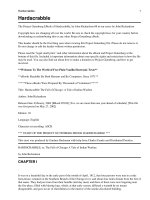Pak1 phosphorylation of snail a master r
Bạn đang xem bản rút gọn của tài liệu. Xem và tải ngay bản đầy đủ của tài liệu tại đây (1.26 MB, 7 trang )
Pak1 Phosphorylation of Snail, a Master Regulator of
Epithelial-to-Mesenchyme Transition, Modulates Snail's
Subcellular Localization and Functions
Zhibo Yang, Suresh Rayala, Diep Nguyen, et al.
Cancer Res 2005;65:3179-3184.
Updated version
Access the most recent version of this article at:
/>
Cited Articles
This article cites by 21 articles, 13 of which you can access for free at:
/>
Citing articles
This article has been cited by 27 HighWire-hosted articles. Access the articles at:
/>
E-mail alerts
Reprints and
Subscriptions
Permissions
Sign up to receive free email-alerts related to this article or journal.
To order reprints of this article or to subscribe to the journal, contact the AACR Publications
Department at
To request permission to re-use all or part of this article, contact the AACR Publications
Department at
Downloaded from cancerres.aacrjournals.org on July 19, 2014. © 2005 American Association for Cancer
Research.
Research Article
Pak1 Phosphorylation of Snail, a Master Regulator of
Epithelial-to-Mesenchyme Transition, Modulates
Snail’s Subcellular Localization and Functions
1
1
1
1
Zhibo Yang, Suresh Rayala, Diep Nguyen, Ratna K. Vadlamudi,
2
1
Shiuan Chen, and Rakesh Kumar
1
2
Department of Molecular and Cellular Oncology, The University of Texas M.D. Anderson Cancer Center, Houston, Texas and
Beckman Research Institute of the City of Hope, Duarte, California
Abstract
The process of epithelial-mesenchymal transition plays a
pivotal role in the conversion of early stage tumors into
invasive malignancies, and has been shown to be regulated by
the zinc finger phosphoprotein, Snail; however, no upstream
signaling kinases have been shown to modulate Snail
functions. Since the invasiveness of breast cancer cells is also
influenced by p21-activated kinase 1 (Pak1) signaling, we
investigated Pak1’s potential mechanistic role in the regulation of Snail functions. We found for the first time that
Pak1 promotes transcription repression activity of Snail from
E-cadherin, occludin, and aromatase promoters. Pak1 regulates the repressor activity of Snail by phosphorylating on
Ser246. Pak1 phosphorylation of Snail supports Snail’s accumulation in the nucleus as well as its repressor functions.
A Ser246Ala substitution in Snail or Pak1 knockdown by
short interference RNA blocked Pak1-mediated Snail phosphorylation, leading to increased cytoplasmic accumulation
of Snail and attenuation of Snail repressor activity in
breast cancer cells. The regulation of phosphorylation and
function of Snail by Pak1 represents a novel mechanism by
which a signaling kinase might contribute to the process of
epithelial-mesenchymal transition. (Cancer Res 2005; 65(8):
3179-84)
Introduction
The small GTPases, including Cdc42 and Rac1, have been
implicated in the regulation of mammalian cell morphology and
motility (1). More specifically, Rac1 induces cortical actin
polymerization, which is seen as membrane ruffling and lamellipodia, and Cdc42 induces the formation of peripheral actin
microspikes and filopodia (2–4). The small GTPases regulate the
formation of cytoskeletal structures by means of a family of serine/
threonine kinases known as p21-activated kinases (Pak). Activation
of Pak1 is accompanied by the disassembly of stress fibers and
focal adhesion complexes, as well as by maintenance of the
integrity of the motile leading edge (5, 6). Pak1 is activated by a
number of growth factors, including heregulin and epidermal
growth factor, which are potent inducers of Pak1 activity and
motility of breast cancer cells (7, 8). Activation of Pak1 involves
autophosphorylation of several sites, including Thr423 within the
autoinhibitory loop of the kinase (9).
Requests for reprints: Rakesh Kumar, Department of Molecular and Cellular
Oncology, The University of Texas M.D. Anderson Cancer Center, 1515 Holcombe
Boulevard, Houston, TX 77030. Phone: 713-745-3558; Fax: 713-745-3792; E-mail:
I2005 American Association for Cancer Research.
www.aacrjournals.org
Recent data suggested that, in addition to cell motility, Pak1 is
also involved in breast cancer progression. Adam et al. (10) have
shown a mechanistic role for Pak1 activation in the increased cell
invasion of breast cancer cells by heregulin. Furthermore,
expression of a kinase-dead Pak1 mutant in the highly invasive
breast cancer cell lines, MDA-MB-435 and MDA-MB-231, led to
stabilization of stress fibers, enhanced cell spreading, and reduction
in invasiveness (11). Conversely, hyperactivation of the Pak1
pathway by conditional expression of catalytically active T423E
Pak1 in the noninvasive breast cancer cell line MCF-7 promotes cell
migration and anchorage-independent growth (12). Interestingly,
highly proliferative human breast cancer cell lines and tumor tissues
have been shown to contain hyperactive Pak1 as well as its
upstream regulator Rac3 (13). Increased Pak1 activity also correlates
well with the invasiveness of human breast cancer cells and breast
tumor grades (12). Expression of Pak1 in human breast tumor tissue
correlates with tumor grade, with higher expression in less
differentiated ductal carcinomas of the breast (grade III tumors)
than in grade II and grade I tumors (14). Emerging data suggests
that Pak1 may be overexpressed in human breast cancer
(12, 14, 15). Inhibition of Pak1 using kinase-dead Pak1-K299R in
highly invasive MDA-MB435 breast cancer cells was associated
with excessive cell spreading and accumulation of mature focal
points (13). Although these observations suggest that Pak1 has a
role in breast cancer progression, its role in epithelialto-mesenchymal transition (EMT) remains unknown.
The process of breast cancer invasion requires, among other
steps, changes in signaling pathways and increased ability to
undergo EMT. One of the critical regulators of EMT is the zinc finger
protein Snail, which promotes the transcriptional repression of Ecadherin, thus allowing cells to detach from their neighbors and
migrate. Most epithelial tumor cell lines exhibit an inverse
correlation between levels of E-cadherin and Snail mRNA (16, 17).
Repression of E-cadherin transcription seems to be specifically
relevant in the late steps of epithelial tumorigenesis, since a causal
relationship exists between the loss of E-cadherin and the invasive
properties of some tumors. Recent studies have shown an
association of Snail expression with the degree of infiltration of
breast carcinomas (17). A recent study suggests that Snail function
may be regulated by its intracellular location, as serine phosphorylation–dependent cytoplasmic redistribution of Snail inhibits its
activity as a transcription repressor (18). A recent study showed that
GSK-3h phosphorylation of Snail promotes its degradation and
thus, could be another mode of Snail regulation of the metastatic
potential of tumor cells (19). Here we set out to gain additional
insights into Snail phosphorylation by signaling pathways. We
present new evidence showing for the first time that Pak1 regulates
the phosphorylation and functions of Snail in breast cancer cells.
3179
Cancer Res 2005; 65: (8). April 15, 2005
Downloaded from cancerres.aacrjournals.org on July 19, 2014. © 2005 American Association for Cancer
Research.
Cancer Research
Figure 1. Status of Snail localization and
Pak1 kinase activity in human breast
cancer cells. A, morphology of MCF-7,
MDA-MB-435, and MDA-MB-231 cells
morphology using phase-contrast
microscopy (top ); localization of Snail in
MCF-7, MDA-MB-435, and MDA-MB-231
cells by confocal microscopy (bottom ;
Â65 magnification); B, RT-PCR analysis
of E-cadherin expression in MCF-7,
MDA-MB-435, and MDA-MB-231 cells; C,
Pak1 kinase activity in breast cancer cells.
Lysates (200 Ag) were immunoprecipitated
with anti-Pak1 antibody, and kinase assays
were done in kinase buffer using myelin
basic protein as a substrate.
Materials and Methods
Cell cultures, reagents, and transfection. Breast cancer cell lines
MCF-7, MDA-MB435, MDA-MD231, and 293 T cells were maintained in
DMEM/F-12 (1:1) supplemented with 10% FCS. Antibodies to Pak1 and Snail
were purchased from Cell Signaling Technology (Boston, MA) and Santa
Cruz Biotechnology (Santa Cruz, CA), respectively. Antibody to E-cadherin
was purchased from Zymed Laboratories (San Francisco, CA). Transient
transfection studies were done using a Fugene-6 kit (Roche Biochemicals,
Indianapolis, IN) in accordance with the manufacturer’s instructions.
Transfection with Pak1 small interfering RNAs (siRNA; Dharmacon,
Lafayette, CO) was carried out in serum-free DMEM/F-12 with LipofectAMINE (Invitrogen, Carlsbad, CA) according to the manufacturer’s
specifications. Both Pak1 siRNA and control siRNA were transfected at a
concentration of 100 nmol/L.
Immunoprecipitation and kinase assay. Cells were subjected to lysis
in a buffer containing 20 mmol/L Tris-HCl (pH 7.5), 100 mmol/L NaCl, 10%
glycerol, 1% NP40, 10 mmol/L NaF, 1 mmol/L NaVO4, and a cocktail of
Figure 2. Pak1-induced repression of the
promoter activities of Snail target genes
E-cadherin, occludin, and aromatase. A,
E-cadherin, occludin, and aromatase
luciferase reporter assay: 100 ng of
luciferase reporter constructs carrying
human E-cadherin, occludin, or aromatase
promoter were transfected into MCF-7 cells
singly or together with the Snail expression
vector with/without cotransfection of
wild-type Pak1 or constitutively active form
Pak1 (423E-Pak1), respectively; B,
E-cadherin and aromatase luciferase
reporter assay: 100 ng of luciferase
reporter constructs carrying human
E-cadherin or occludin promoters was
transfected into MCF-7 cells singly or
together with the dominant-negative Pak1
autoinhibitory fragment (residues 83-149)
expression vector, respectively; C,
E-cadherin and occludin luciferase reporter
assay after siRNA-mediated inhibition of
Pak1 expression. Transfection with Pak1
siRNA was carried out in serum-free
DMEM/F-12 with LipofectAMINE into
MCF-7 cells according to the
manufacturer’s specifications. Either Pak1
siRNA or control siRNA was transfected at
a concentration of 100 nmol/L. Two days
after siRNA transfection, 100 ng of
luciferase reporter constructs carrying
human E-cadherin or occludin promoter
were transfected, respectively. The
inhibition of Pak1 expression mediated by
Pak1 siRNA was shown by Western
blotting, and equal loading was indicated by
anti-vinculin antibody (inset ). All assays
were done in triplicate and all results
correspond to the average of three
independent experiments. Columns , mean;
bars, F SD.
Cancer Res 2005; 65: (8). April 15, 2005
3180
www.aacrjournals.org
Downloaded from cancerres.aacrjournals.org on July 19, 2014. © 2005 American Association for Cancer
Research.
Signaling and Epithelial-to-Mesenchymal Transition
Figure 3. Pak1 Regulation on the expression of E-cadherin. A, down-regulation
of E-cadherin expression in MCF-7 cells by transient transfection of myc-tagged
Pak; B, up-regulation of E-cadherin expression in MDA-MB-435 cells by
inhibition of Pak1 expression mediated by Pak1 siRNA.
protease inhibitors. In in vitro kinase assays using myelin basic protein as
the substrate, Pak1 was immunoprecipitated from 200 AL of the cell lysates
with Pak1 antibody as described elsewhere (9). When indicated, the
immunocomplex was washed with kinase buffer [20 mmol/L HEPES (pH
7.4), 1 mmol/L DTT, 10 mmol/L MnCl2, and 10 mmol/L MgCl2].
Plasmid construction. We generated Snail constructs tagged with Gal4,
glutathione S-transferase (GST), or HA by amplifying the selected region of
Snail and then subcloning it into the BamHI and XhoI sites of the Gal4
(Clontech, Palo Alto, CA), pGEX5X (Amersham Pharmacia, Piscataway, NJ),
or pcDNA3.1 (Invitrogen) vectors. We generated mutations in the
expression vector for full-length Snail by site-directed mutagenesis using
the Quick Change kit (Stratagene, La Jolla, CA), and the sequences of
resulting mutant Snail constructs were verified by direct sequencing at the
M.D. Anderson Cancer Center core facility.
In vitro phosphorylation. Using GST-Filamin as the positive control and
GST-Snail protein (4 Ag each) as the substrate, this assay was done in
HEPES buffer (50 mmol/L HEPES, 10 mmol/L MgCl2, 2 mmol/L MnCl2,
0.2 mmol/L DTT) containing 100 ng of purified bacterially expressed GSTPak1 enzyme, 10 ACi of g-[32P]-ATP, and 25 Amol/L of cold ATP (9).
In vivo phosphorylation. 293 T cells were transfected with either Snail
expression vector or the construct with point mutation S246A and
cotransfected with wild-type Pak1 or a constitutively active form of Pak1
(423E). Cells were labeled with [32P]orthophosphoric acid overnight.
Twenty-four hours after transfection, cell lysates were immunoprecipitated
with an anti-HA monoclonal antibody (mAb) and then separated by 10%
SDS-PAGE. Labeling was visualized by autoradiography with a PhosphorImager (9).
Promoter-reporter assays. Subconfluent human breast cancer cells,
cultured in six-well plates, were transiently cotransfected with 100 ng of Ecadherin, occludin (20), or aromatase (21) promoter-luciferase reporter, and
cotransfected in the presence or absence of 500 ng Snail, Pak1, or T423EPak1 (12), together with 20 ng of h-galactosidase, using the Fugene-6
reagent according to the manufacturer’s protocol (Roche Applied Science,
Indianapolis, IN). Twenty-four hours after transfection, cells were subjected
to lysis with passive lysis buffer, and luciferase assay was done using the
luciferase reporter assay kit (Promega, Madison, WI). h-Galactosidase
activity was used to normalize the transfection. Each transfection was done
in triplicate wells.
Reverse transcription-PCR. Total RNA was isolated from MCF-7, MDAMB435, and MDA-MD231 breast cancer cells using the TRIzol Reagent (Life
Technologies, Inc., Grand Island, NY), and 100 ng of each RNA sample was
analyzed by reverse transcription (RT)-PCR. Isolated RNA was reversetranscribed and amplified using the One-Step RT-PCR System (Promega).
Figure 4. Pak1 regulation of Snail
subcellular localization and
phosphorylation. A, confocal microscopic
analysis of Snail (red ) localization in
MDA-MB-231 cells as affected by inhibition
of Pak1 expression (green ) with Pak1
siRNA (Â65 magnification); B, Pak1
phosphorylated Snail in a dose-dependent
manner. Filamin was used as the positive
control in this in vitro phosphorylation
assay; C, in vivo phosphorylation of
Snail by Pak1. 293 T cells were
serum-starved for 1 day and then
transfected with Snail expression vector
together with either wild-type Pak1
or constitutively active form of Pak1
(423E). Cells were labeled with
[32P]orthophosphoric acid and cell
lysates were immunoprecipitated with an
anti-HA mAb. Phosphorylation was
visualized by autoradiography with a
PhosphoImager. Equal loading was
indicated by Ponceau staining (bottom ).
www.aacrjournals.org
3181
Cancer Res 2005; 65: (8). April 15, 2005
Downloaded from cancerres.aacrjournals.org on July 19, 2014. © 2005 American Association for Cancer
Research.
Cancer Research
Primer sequences used were E-cadherin forward (5V-GGC CTG AAG TGA
CTC GTA ACG A-3V) and E-cadherin reverse (5V-GCT CAG ACT AGC AGC
TTC GGA AC-3V), or glyceraldehyde-3-phosphate dehydrogenase (GAPDH)
forward (5V-CCA TCT TCC AGG AGC GAG ATC-3V) and GAPDH reverse (5VCGT TCA GCT CAG GGA TGA CC-3V). Amplification was conducted
in 20 AL reactions each containing 50 ng total RNA, 0.2 mmol/L
deoxynucleotide triphosphate, 1 mmol/L MgCl2, 1 Amol/L of each primer,
0.5 units of avian myeloblastosis virus, 0.5 units of Tfl DNA polymerase, and
reaction buffer. The cycling conditions included an initial incubation at 48jC
for 45 minutes and second incubation at 94jC for 2 minutes, followed by 35
cycles comprising 30 seconds at 94jC, 30 seconds at 60jC, and 1 minute at
68jC. The final extension was 7 minutes at 68jC. The RT-PCR product for Ecadherin is 203 bp, and 451 bp for GAPDH. RT-PCR products were separated
on 2% agarose gels.
Immunofluorescence and confocal studies. The cellular location of
proteins was determined by using indirect immunofluorescence (9).
Briefly, cells grown on glass coverslips were fixed in methanol at À20jC
for 6 minutes. Cells were incubated with primary antibodies for 2 hours at
room temperature, washed thrice with PBS, and then incubated with
546Alexa (red)-, 633Alexa (blue)-, or 488 Alexa (green)-labeled secondary
antibodies (Molecular Probes, Orlando, FL). The DNA dye Topro-3 was used
to costain the DNA, which gives an emission in the far-red segment of the
light spectrum and color-coded in blue (Molecular Probes). Confocal
analysis was done with a Zeiss laser-scanning confocal microscope using
established methods of processing of the same section for each detector
(the three excitations corresponding to 546, 488, or 633 nm), comparing the
sections pixel by pixel.
Results and Discussion
Figure 5. Phosphorylation of Snail on Ser246 by Pak1. A, snail amino acid
sequence showing the possible Pak1 phosphorylation sites. Potential Pak1
phosphorylation sites are underlined and the identified Pak1 phosphorylation site
is encircled; B, in vitro phosphorylation of Snail deletion constructs by Pak1.
All five different point mutation constructs were made from a Snail deletion
construct (amino acids 181-264). Equal loading is indicated by Ponceau
staining (bottom ); C, in vitro phosphorylation of Snail full-length and deletion
constructs with/without point mutation of S246A by Pak1. The equal loading was
indicated by Ponceau staining (left ); D, in vivo phosphorylation of Snail on Ser246
by Pak1. 293 T cells cultured in DMEM/F-12 (1:1) supplemented with 10%
FCS were transfected with either Snail expression vector or the construct with
point mutation S246A and cotransfected with wild-type Pak1 or a constitutively
active form of Pak1 (423E). Cells were labeled with [32P]orthophosphoric
acid and cell lysates were immunoprecipitated with an anti-HA mAb.
Phosphorylation was visualized by autoradiography with a PhosphorImager.
Equal loading is indicated by Ponceau staining (bottom ).
Cancer Res 2005; 65: (8). April 15, 2005
The process of EMT, the hallmark of invasiveness, is characterized by distinct spindle-like morphologic alteration. To understand the significance of signaling pathways in EMT, we initially
compared the morphologies of densely plated invasive breast
cancer MDA-MB231 and MDA-MB435 cells with the morphology of
noninvasive MCF-7 cells. As expected, invasive breast cancer cells
exhibited spindle-like morphology with fewer cell-cell interactions
than MCF-7 cells (Fig. 1A). Since repression of E-cadherin
transcription is particularly relevant in the late steps of epithelial
tumorigenesis, both MDA-MB231 and MDA-MB435 cells contained
substantially lower levels of E-cadherin than MCF-7 cells (Fig. 1B).
Since recent data have implicated Pak1 signaling in breast cancer
invasiveness (13–15), we next evaluated Pak1 activity in these
breast cancer cell lines. MDA-MB231 and MDA-MB435 cells
contained significantly greater levels of Pak1 activity than MCF-7
cells (Fig. 1C).
To explore a potential effect of Pak1 signaling upon the functions
of Snail, we next examined the influence of Pak1 upon the ability of
Snail to repress E-cadherin promoter activity. Our results showed
that both wild-type Pak1 and catalytically active T423E-Pak1 (423E)
had an inhibitory effect on E-cadherin promoter activity (Fig. 2A,
left). Furthermore, Pak1 enhanced the ability of Snail to repress Ecadherin promoter activity (Fig. 2A, left). To evaluate the generality
of these findings, we examined the effect of Pak1 on two additional
Snail-regulated genes, tight junction membrane protein occludin
(20) and estrogen synthetase enzyme aromatase (21). Interestingly,
we found that Pak1 expression also promotes the ability of Snail to
repress transcription from both occludin- and aromatase-promoter
reporters (Fig. 2A, middle and right). Consistent with a role for
Pak1 in modulating Snail activity, inhibition of Pak1 activity with a
dominant-negative Pak1 autoinhibitory fragment (residues 83-149)
relieved, at least in part, the repression effects of Snail on Ecadherin and occludin promoter activity (Fig. 2B). We next showed
that inhibition of the Pak1 pathway by Pak1-specific siRNA resulted
in increased transcriptional activity from E-cadherin and occludin
promoters (Fig. 2C). To validate these findings, we investigated
whether Pak1 regulates the expression of endogenous E-cadherin,
the Snail target gene, in breast cancer cell lines. Convincingly, we
noticed that E-cadherin expression in MCF-7 cells was downregulated upon transfection of myc-tagged Pak1 (Fig. 3A), and
conversely, E-cadherin expression in MDA-MB-435 cells was upregulated through inhibition of Pak1 expression mediated by Pak1
3182
www.aacrjournals.org
Downloaded from cancerres.aacrjournals.org on July 19, 2014. © 2005 American Association for Cancer
Research.
Signaling and Epithelial-to-Mesenchymal Transition
Figure 6. Pak1 phosphorylation is
essential for Snail function. A, E-cadherin,
occludin and aromatase luciferase reporter
assays: 100 ng of luciferase reporter
constructs carrying human E-cadherin,
occludin, or aromatase promoter were
transfected into MCF-7 cells singly or
together with either the Snail expression
vector or the construct with point mutation
of S246A, respectively. All these luciferase
reporter assays were done in triplicate, and
all results correspond to the average of
three independent experiments. Columns,
mean; bars , F SD; B, confocal microscopic
analysis of localization of Snail-246A.
MCF-7 cells were transfected with either
the Snail expression vector (red, top ) or the
construct with point mutation of S246A
(red, bottom ) as indicated, together with
myc-tagged Pak1 (green ). Twenty-four
hours after transfection, cells were fixed
with methanol for 5 minutes at À20jC, and
localization of Snail was analyzed by using
indirect immunofluorescence and
counterstained for nuclear DNA (blue ) with
Topro 3 (Â65 magnification).
siRNA (Fig. 3B). Since the significance of E-cadherin in the process
of EMT is well established, these results suggested that Pak1 might
play its role in breast cancer progression and also in EMT by
regulating the expression of E-cadherin via Snail.
To gain deeper insight into the mechanism of Pak1 regulation
of Snail functions, we next examined the effect of knocked-down
Pak1 expression with siRNA upon the subcellular localization of
Snail in MDA-MB231 cells by scanning confocal microscopy. We
found that inhibition of Pak1 expression leads to almost complete
disappearance of nuclear Snail in MDA-MB231 cells (Fig. 4A). The
increased level of Pak1 activity has been shown to correlate well
with the invasiveness of human breast cancer cells and tumors
(13–15); hyperactivation of the Pak1 pathway in the noninvasive
breast cancer cell line MCF-7 promotes cell invasiveness (11),
raising the possibility that Pak1 signaling might affect the
phosphorylation status of Snail and could influence the functions
of Snail.
To directly test the above hypothesis, we first identified five
potential Pak1 phosphorylation sites in Snail (Fig. 5A, underlined).
To determine if Snail was a kinase substrate of Pak1, an in vitro
kinase assay was carried out using purified Pak1 enzyme and
www.aacrjournals.org
purified GST-Snail. Interestingly, we noticed dose-dependent
phosphorylation of Snail by Pak1 enzyme (Fig. 4B), suggesting
that Snail might be a novel substrate of Pak1. To confirm this
finding, we then did the in vivo Snail phosphorylation assay. We
cotransfected serum-starved 293 T cells with HA-tagged Snail, with
or without catalytically active T423E Pak1, and cells were
metabolically labeled with [32P]orthophosphoric acid. Results
showed that HA-Snail can be phosphorylated by catalytically
active T423E Pak1, instead of wild-type Pak1, in serum-starved
conditions (Fig. 4C). To map the Pak1 phosphorylation site in
Snail, we next substituted all potential serine or threonine residues
with alanine in the potential Pak1 phosphorylation sites in Snail by
site-directed mutagenesis and generated Snail mutants Thr203Ala,
Ser221Ala, Thr229Ala, Thr257Ala, and Ser246Ala to test in vitro (Fig. 5B
and C) and in an in vivo phosphorylation assay (Fig. 5D). The site
of Pak1 phosphorylation on Snail was identified as Ser246.
To show the functionality of the Pak1 phosphorylation site in
Snail, we next compared the repression activity of Snail Ser246Ala
mutant with that of wild-type Snail against a Snail-target gene
reporter assay. We found that Snail-mediated repression of
transcription from the E-cadherin, occludin and aromatase
3183
Cancer Res 2005; 65: (8). April 15, 2005
Downloaded from cancerres.aacrjournals.org on July 19, 2014. © 2005 American Association for Cancer
Research.
Cancer Research
promoters were significantly relieved by the mutant Snail Ser246Ala
(Fig. 6A), suggesting a mechanistic role for Pak1 phosphorylation of
Snail on Ser246 in regulating the functions of Snail. To delineate the
potential mechanism by which Pak1 phosphorylation regulates
Snail function, we examined the subcellular localization of Snail in
MCF-7 cells, expressing myc-Pak1 with either wild-type HA-Snail or
mutant HA-Snail Ser246Ala (Fig. 6B). We found that the wild-type
Snail localizes in both the cytoplasm and in the nucleus, whereas
the mutant Snail Ser246Ala preferentially localized in the cytoplasmic compartment. These results suggested that Pak1 phosphorylation of Snail modulates its transcriptional activity by promoting
increased accumulation of Snail in the nucleus, an increasing
accepted mode of influencing transcription functions of coregulators such as p53, C-terminal Binding Protein, and Forkhead
transcription factor.
Since Pak1 has now been shown to be present in both the
cytoplasmic and the nuclear compartments (9–12), and because
Pak1 also contains nuclear localization signal, which subcellular
compartment is responsible for Pak1 phosphorylation of Snail and/
or if Snail phosphorylation also influences its import or export
from the nucleus remain unknown. Since Snail contains a nuclear
References
1. Narumiya S, Ishizaki T, Watanabe N. Rho effectors and
reorganization of actin cytoskeleton. FEBS Lett 1997;
410:68–72.
2. Ridley AJ, Hall A. The small GTP-binding protein rho
regulates the assembly of focal adhesions and actin
stress fibers in response to growth factors. Cell 1992;
70:389–99.
3. Kozma R, Ahmed S, Best A, Lim L. The Ras-related
protein Cdc42Hs and bradykinin promote formation of
peripheral actin microspikes and filopodia in Swiss 3T3
fibroblasts. Mol Cell Biol 1995;15:1942–52.
4. Nobes CD, Hall A. Rho, rac, and cdc42 GTPases
regulate the assembly of multimolecular focal complexes associated with actin stress fibers, lamellipodia,
and filopodia. Cell 1995;81:53–62.
5. Zhao ZS, Manser E, Chen XQ, Chong C, Leung T, Lim
LA. Conserved negative regulatory region in aPAK:
inhibition of PAK kinases reveals their morphological
roles downstream of Cdc42 and Rac1. Mol Cell Biol
1998;18:2153–63.
6. Manser E, Huang HY, Loo TH, et al. Expression of
constitutively active a-PAK reveals effects of the kinase
on actin and focal complexes. Mol Cell Biol 1997;17:
1129–43.
7. Galiesteo ML, Chernoff J, Su YC, Skolnik EY,
Schlessinger J. The adaptor protein Nck links
receptor tyrosine kinases with the serine-threonine
kinase Pak1. J Biol Chem 1996;271:20997–1000.
Cancer Res 2005; 65: (8). April 15, 2005
export sequence (18), phosphorylation of an adjacent serine-rich
sequence may make this nuclear export sequence accessible to the
CRM1 transporter, thus facilitating translocation of the Snail
protein to the nucleus. These issues have not been investigated
here, and will be addressed in detail in our planned future studies.
In summary, results presented here show for the first time that
Pak1 phosphorylation of Snail on Ser246 promotes Snail’s nuclear
accumulation and consequently its repressor activity in the
nucleus. Since Pak1 is a major signaling nodule of extracellular
stimuli and growth factor pathways that are widely implicated in
the process of EMT, it is possible that Pak1 signaling or its
upstream regulators might constitute an important modifier of
EMT by directly phosphorylating Snail on Ser246.
Acknowledgments
Received 9/27/2004; revised 11/19/2004; accepted 1/16/2005.
Grant support: NIH grants CA090970 and CA080066 (R. Kumar).
The costs of publication of this article were defrayed in part by the payment of page
charges. This article must therefore be hereby marked advertisement in accordance
with 18 U.S.C. Section 1734 solely to indicate this fact.
We thank E. Fearon for the pGL2-E-cadherin promoter luciferase reporter and
S. Tsukita for the occludin promoter luciferase reporter.
8. Bagheri-Yarmand R, Vadlamudi RK, Wang RA,
Mendelsohn J, Kumar R. Vascular endothelial growth
factor up-regulation via p21-activated kinase-1 signaling regulates heregulin-h1-mediated angiogenesis.
J Biol Chem 2000;275:39451–7.
9. Vadlamudi RK, Li F, Adam L, et al. Filamin is essential
in actin cytoskeletal assembly mediated by p21activated kinase 1. Nat Cell Biol 2002;4:681–90.
10. Adam L, Vadlamudi RK, Kondapaka SB, Chernoff J,
Mendelsohn J, Kumar R. Heregulin regulates cytoskeletal reorganization and cell migration through the p21activated kinase-1 via phosphatidylinositol-3 kinase.
J Biol Chem 1998;273:28238–46.
11. Adam L, Vadlamudi RK, Mandal M, Chernoff J,
Kumar R. Regulation of microfilament reorganization
and invasiveness of breast cancer cells by kinasedead p21-activated kinase-1. J Biol Chem 2000;275:
12041–50.
12. Vadlamudi RK, Adam L, Wang RA, et al. Regulatable
expression of p21-activated kinase-1 promotes anchorageindependent growth and abnormal organization of
mitotic spindles in human epithelial breast cancer cells.
J Biol Chem 2000;275:36238–44.
13. Mira JP, Benard V, Groffen J, Sanders LC, Knaus UG.
Endogenous, hyperactive Rac3 controls proliferation of
breast cancer cells by a p21-activated kinase-dependent
pathway. Proc Natl Acad Sci U S A 2000;97:185–9.
14. Salh B, Marotta A, Wagey R, Sayed M, Pelech S.
Dysregulation of phosphatidylinositol 3-kinase and
3184
downstream effectors in human breast cancer. Int J
Cancer 2002;98:148–54.
15. Stofega MR, Sanders LC, Gardiner EM, Bokoch GM.
Constitutive p21-activated kinase (PAK) activation in
breast cancer cells as a result of mislocalization of PAK
to focal adhesions. Mol Biol Cell 2004;15:2965–77.
16. Batlle E, Sancho E, Francı´ C, et al. The transcription
factor Snail is a repressor of E-cadherin gene expression
in epithelial tumor cells. Nat Cell Biol 2000;2:84–9.
17. Blanco MJ, Moreno-Bueno G, Sarrio D, et al.
Correlation of Snail expression with histological grade
and lymph node status in breast carcinomas. Oncogene
2002;21:3241–6.
18. Dominguez D, Montserrat-Sentis B, Virgos-Soler A,
et al. Phosphorylation regulates the subcellular location
and activity of the snail transcriptional repressor. Mol
Cell Biol 2003;23:5078–89.
19. Zhou BP, Deng J, Xia W, et al. Dual regulation of Snail
by GSK-3h-mediated phosphorylation in control of
epithelial-mesenchymal transition. Nat Cell Biol 2004;
6:931–40.
20. Ikenouchi J, Matsuda M, Furuse M, Tsukita S.
Regulation of tight junctions during the epitheliummesenchyme transition: direct repression of the gene
expression of claudins/occludin by Snail. J Cell Sci
2003;116:1959–67.
21. Okubo T, Truong TK, Yu B, et al. Down-regulation of
promoter 1.3 activity of the human aromatase gene in
breast tissue by zinc-finger protein, Snail (SnaH).
Cancer Res 2001;61:1338–46.
www.aacrjournals.org
Downloaded from cancerres.aacrjournals.org on July 19, 2014. © 2005 American Association for Cancer
Research.









